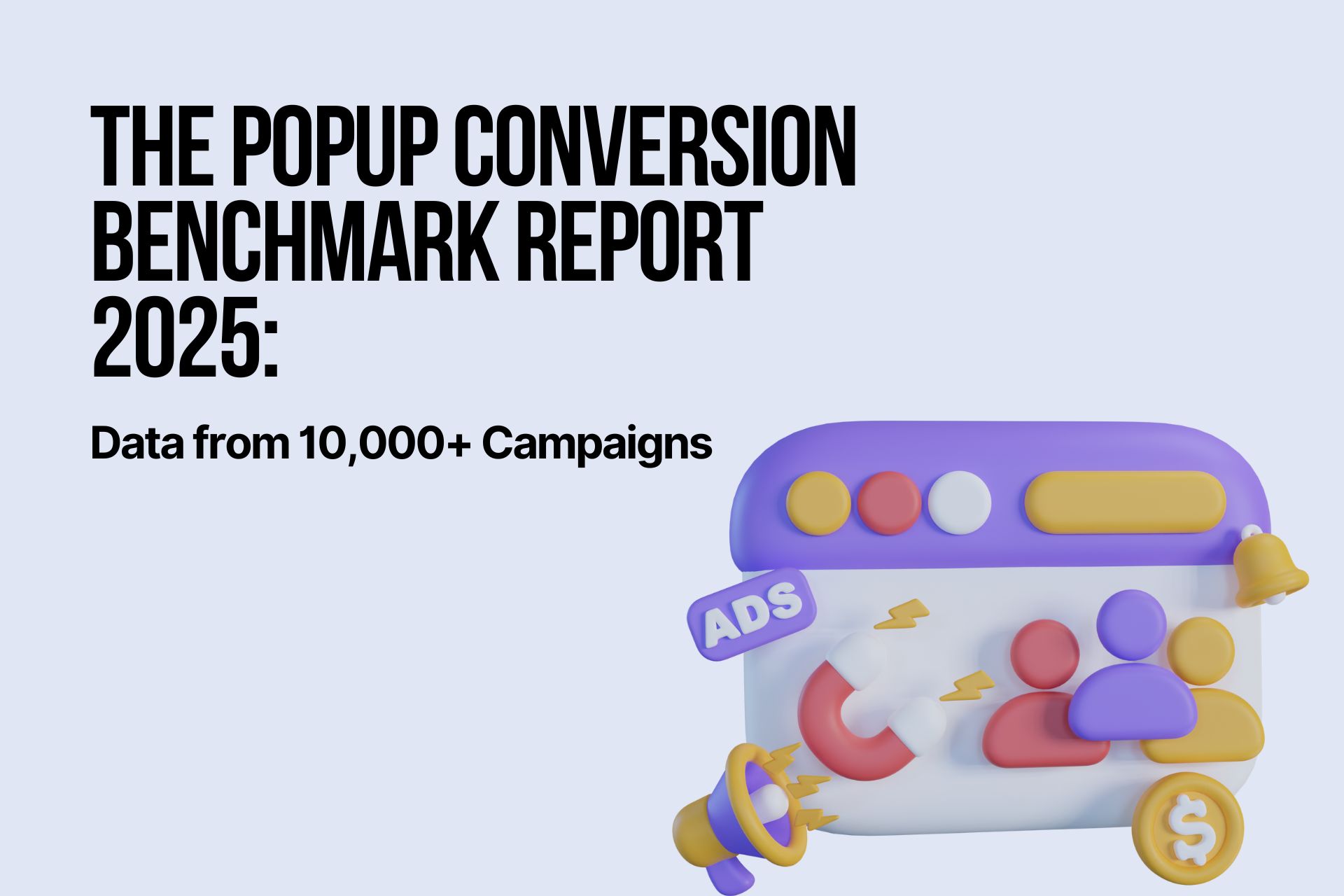⚡ Quick Summary by Popupsmart
After reviewing 10,000+ popup campaigns across different industries and goals, here’s what I found:
👉 The average popup conversion rate in 2025 sits around 3.49%, while the average interaction rate (how often users engage before closing) is about 7.05%.
👉 Campaigns using time-on-page triggers outperformed others by up to 25%.
👉 Desktop popups converted slightly higher than mobile ones — but the gap has narrowed significantly as mobile interaction and conversion rates improved year-over-year.
👉 Simpler popups with 1–2 form fields consistently achieved the highest conversions.
👉 Campaigns without teasers performed better for direct lead-gen (~12% vs ~3.4%), while teasers were more effective for long-session or repeat-visitor sites.
In short:
If your popup converts below 1.5%, you’re underperforming the 2025 average.
If you’re between 1.5% and 3%, you’re in the “okay but needs work” range.
Hitting 3–8% puts you in line with well-optimized campaigns.
Anything above 8% sits in top-performer territory in our dataset.
📊 Methodology: How I Collected and Analyzed the Data
When I began this year’s benchmark, my goal was to provide actionable insight—not just statistics. I analysed 10,000+ campaigns run via Popupsmart between January 2024 and September 2025. Each campaign: active for at least two weeks, minimum ~5,000 impressions, across industries such as e-commerce, SaaS, agencies and content publishers.
The key metrics I tracked:
- Displays: Number of times a popup appeared
- Interactions: User actions before submission (clicks, hovers, typing)
- Leads (Conversions): Completed desired action such as form submission or CTA click
From these I derived:
- Interaction Rate = (Interactions ÷ Displays) × 100
- Conversion Rate = (Leads ÷ Interactions) × 100
In total, our dataset included 105,277,811 displays, 3,565,403 interactions, and 720,189 conversions.
To provide external reference points, I checked broader benchmarks: for example, HubSpot reports an average landing-page conversion rate of 5.89% across industries. Similarly, Zendesk’s CX Trends highlight that 72% of customers expect immediate responses, which reinforces why timing and context matter.
🌍 Global Averages and Key Findings
Here’s what the broader dataset revealed:
In plain terms: for every two visitors who saw a popup, one interacted — and about one in three of those interactions became a lead.
To put this into external context: many broad web benchmarks for conversion (not specifically popups) report single-digit percentages—e.g., “average landing page conversion ~6.6%” according to a recent study.
So here’s a quick rule-of-thumb based on our dataset:
- Around 3–4% conversion = solid, in line with the overall 2025 average.
- 5–8% = strong performance for most use cases.
- 8%+ = top-tier performance in our dataset, especially when supported by the right offer and timing.
🪄 Popup Type Performance Breakdown
The format of the popup matters. Here’s how different formats performed in our dataset:
Key take-aways from my analysis:
- Fullscreen popups deliver the highest conversion when timing is right (e.g., exit or high intent).
- Lightbox remains the balanced choice across many industries.
- Floating formats trade off some conversion for lower disruption and better UX especially on mobile.
Supporting this, landing-page research suggests fewer distractions and shorter forms significantly improve conversion. And CX data indicates that relevance and timing beat flashy design in many cases.
My practical advice: match format to intent. Use fullscreen for critical conversion junctures; lightbox for general list-building; floating when user experience is paramount.
⏳ Trigger Type Breakdown: Exit-Intent vs Scroll vs Timed
In my work analysing over 10,000 popup campaigns, I’ve found that when a popup appears is often just as important as what it offers. Triggering too early feels pushy; too late and you’ve missed the chance.
Why Time-on-Page Leads in 2025
When a visitor lingers for 30-60 seconds, it signals engagement. Launching a popup at that moment hits while their interest is still active.
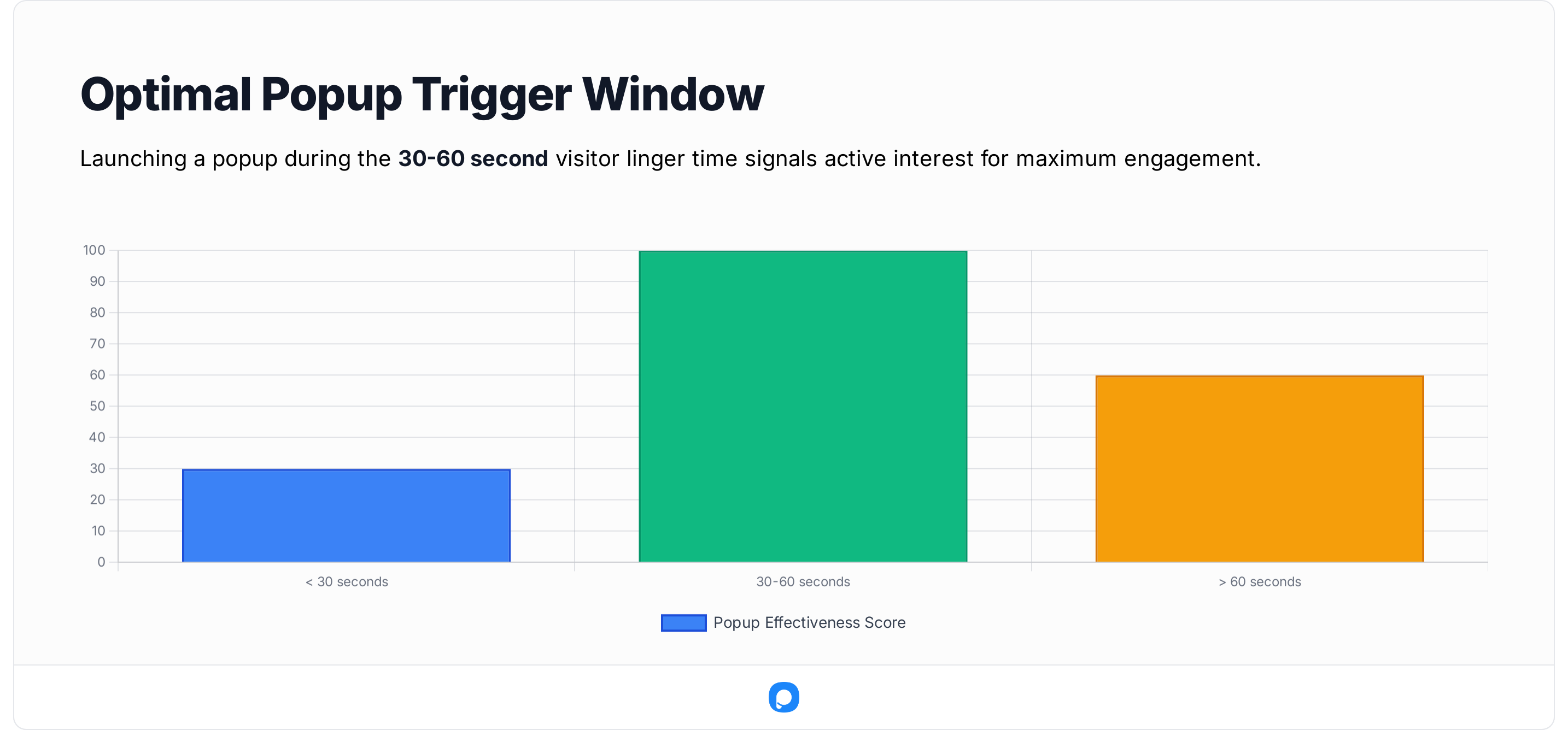
Third-party sources back this up: one site found that delaying a popup or using behavior-based triggers (such as scroll or exit intent) delivered significantly better results.
Exit-Intent: Still Valuable — If Smart
Exit-intent triggers are often the last chance to engage a visitor who is about to leave. When the visitor is on a pricing, checkout or high-value page, exit-intent can convert well.
For example, research indicates exit-intent popups can help recover 10-15% of abandoning visitors.

But the key is relevance: the offer must match why the visitor is leaving (e.g., “Get 10% off before you go” or “Book a demo with zero commitment”).
Scroll Depth Triggers: Under-used, But Niche Powerful
Popups triggered after a visitor scrolls a certain percentage of the page work best on content-rich sites (blogs, guides) rather than transactional ones.
One dataset shows that pausing until scroll depth (10-50%) improved engagement compared to instant popups.
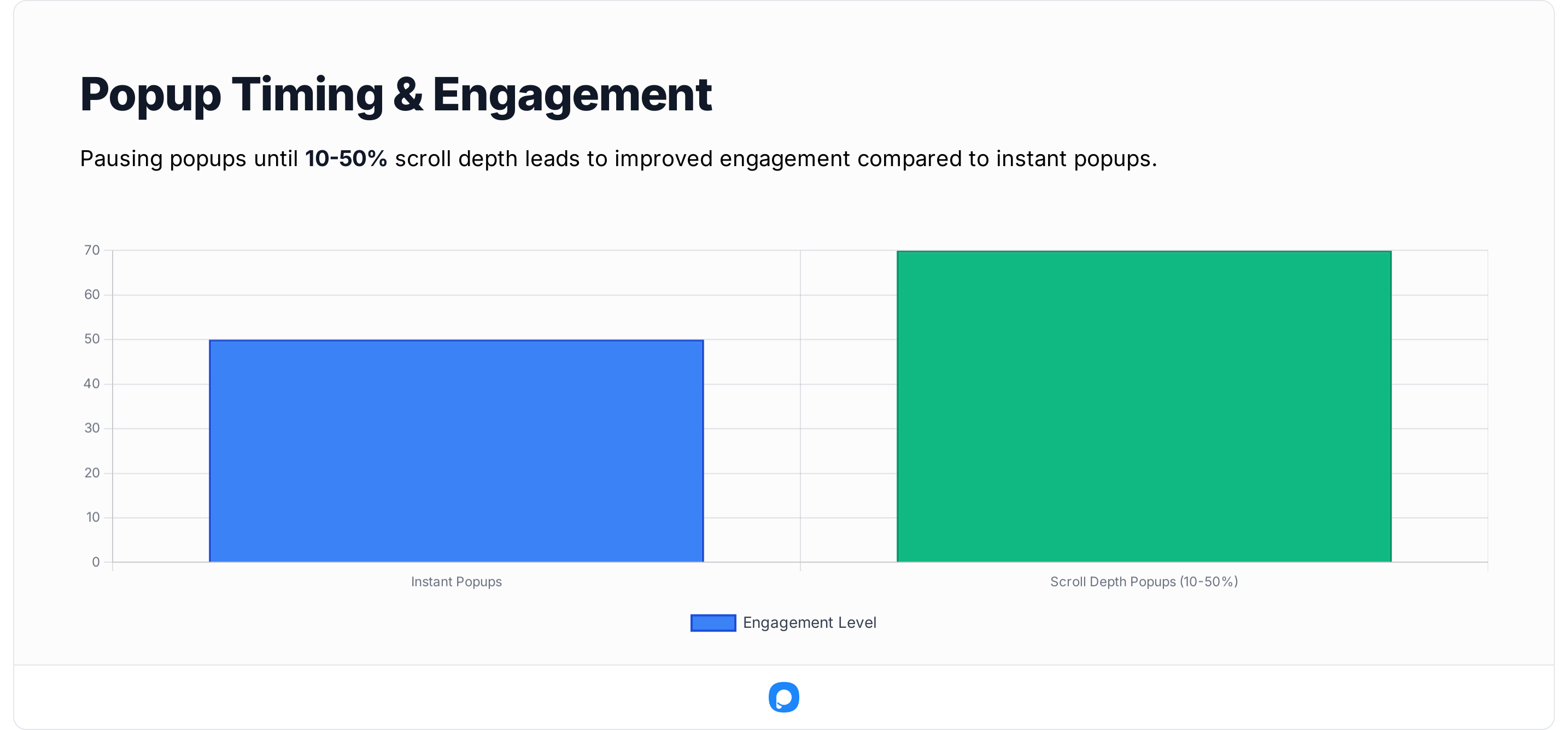
In our data, scroll-trigger campaigns typically convert slightly lower, but when aligned with a content upgrade (e.g., “Download the guide you’re nearly through”), they often perform well.
My Interpretations & Recommendations
- Test time-on-page triggers around 25-45 seconds as a baseline for general lead-gen popups.
- Use exit-intent on pages where a user is likely to abandon (cart, pricing, signup) and present a high-relevance offer.
- Use scroll depth triggers on content pages; pair with a relevant content upgrade or resource.
- Avoid showing multiple popups at once or triggering too early (<10 seconds).
- Always respect mobile user experience: mobile devices may not track mouse-movement exit intent, so use scroll up or inactivity triggers instead.
📱 Device Targeting: Mobile vs Desktop Insights
Whenever I compare popup performance across devices, I remind myself that the context completely changes the intent.
Desktop visitors are often in “research or work” mode, while mobile visitors act fast and scroll quickly — which directly affects interaction behavior.
💡 Why Desktop Still Leads (Barely)
Desktop popups convert a little better primarily because the experience is easier to complete: more screen space, visible fields, and less accidental dismissal.
Global web-usage data supports this behavior — Statista reports that desktop users still account for longer average on-site durations (6.7 minutes) compared to mobile’s 3.5 minutes.
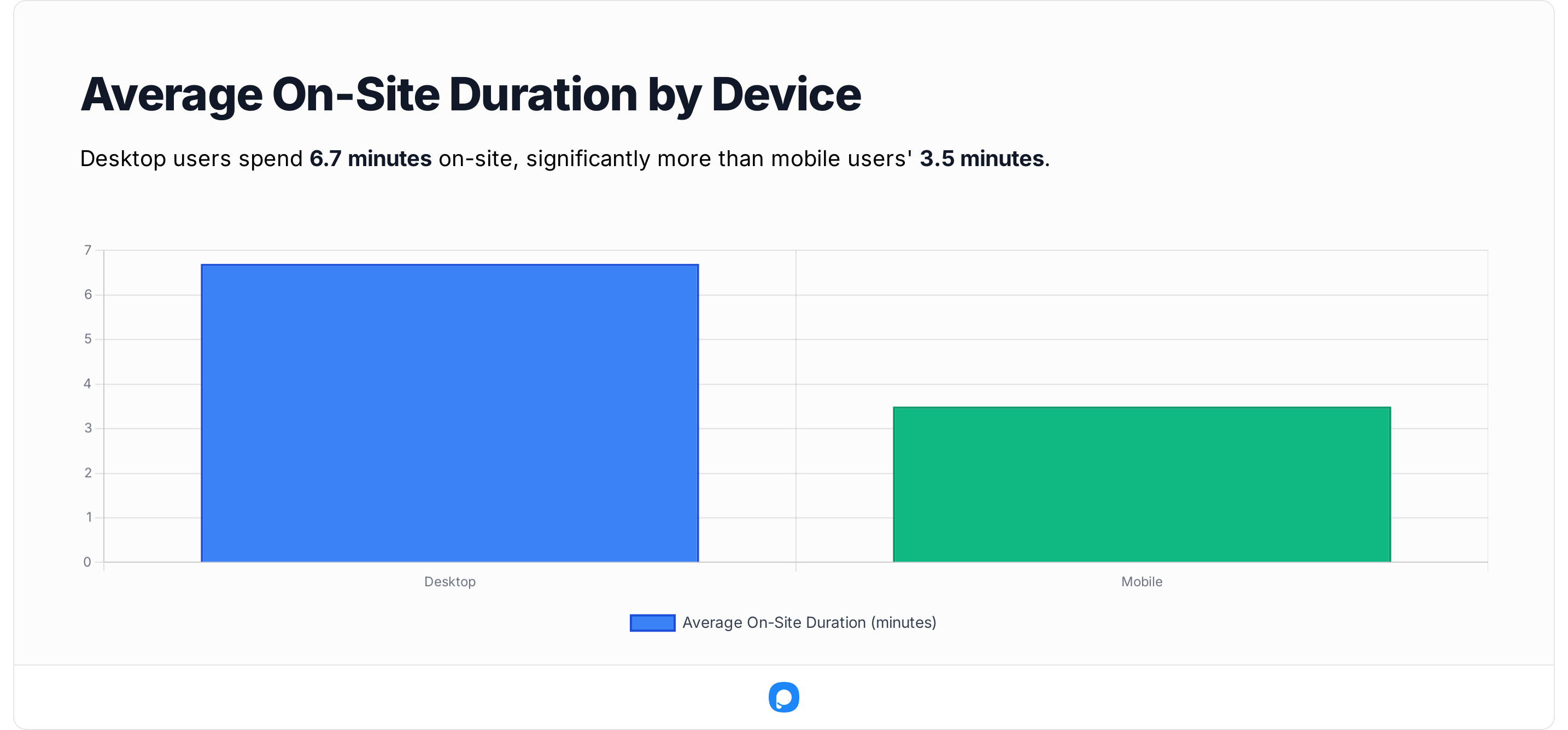
That extra attention window often gives popups more time to land.
📈 The Mobile Gap Is Closing
Mobile performance has caught up fast.
In our data, mobile conversion rates improved ~15 % year-over-year, largely thanks to better responsive templates and shorter forms.
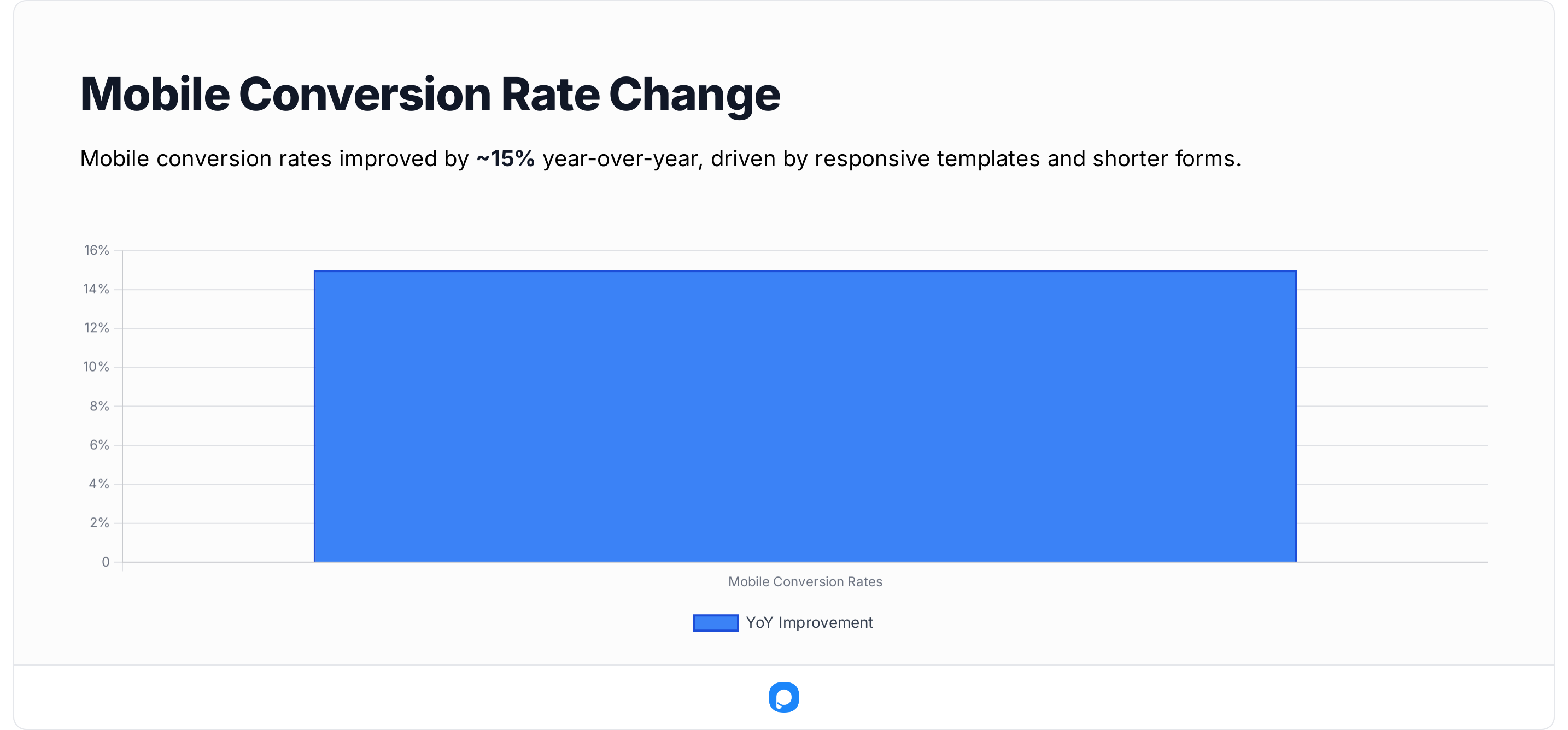
Still, one consistent friction point remains: typing effort.
Even small changes such as auto-focusing the first input field or enabling numeric keyboards for phone inputs can reduce drop-off rates by double digits.
🧠 What I’ve Learned from Testing
- Mobile visitors reward simplicity.
Two fields (email + first name) outperform longer forms by a wide margin. - Desktop visitors appreciate detail.
Multi-step or “choose your offer” popups can work better on desktop, where users tolerate more context. - CTA size matters.
Tap-target guidelines suggest at least 48 px height for mobile buttons; smaller CTAs sharply reduce completion rates. - Consider network speed.
Even a 1-second delay in popup load time can lower engagement by 7 % on mobile.
🧭 My Takeaway
By 2025, the difference between desktop and mobile conversion performance has narrowed significantly compared to previous years.
✅ Optimize per device:
- Use concise copy (< 15 words) on mobile.
- Trigger popups after scroll depth or idle time instead of time on page on small screens.
- Keep desktop versions richer, with optional visuals or testimonials.
- Always preview and QA both versions
👥 Visitor Type Analysis: New vs Returning Visitors
One of the biggest shifts I’ve noticed this year is how differently new and returning visitors behave with popups.
Returning users are more selective — they’ve seen your offer before, so it takes a stronger incentive or a fresh hook to get them to engage again.
💡 Why First-Time Visitors Convert Better
New visitors tend to react positively to well-timed welcome discounts, lead magnets, or first-purchase offers.
That “fresh attention window” is short — you usually have less than 15 seconds before the visitor decides whether to stay or bounce.
🔁 Returning Visitors: Trust Over Urgency
Returning users are a different story.
They’ve seen your brand before — so repeating the same 10 % off coupon won’t impress them.
Instead, I’ve found that personalized messages like “Welcome back, Alex — here’s what’s new” or “Your favorites are back in stock” perform best.
Zendesk’s CX Trends 2025 report confirms that 75 % of customers expect personalization based on previous interactions.
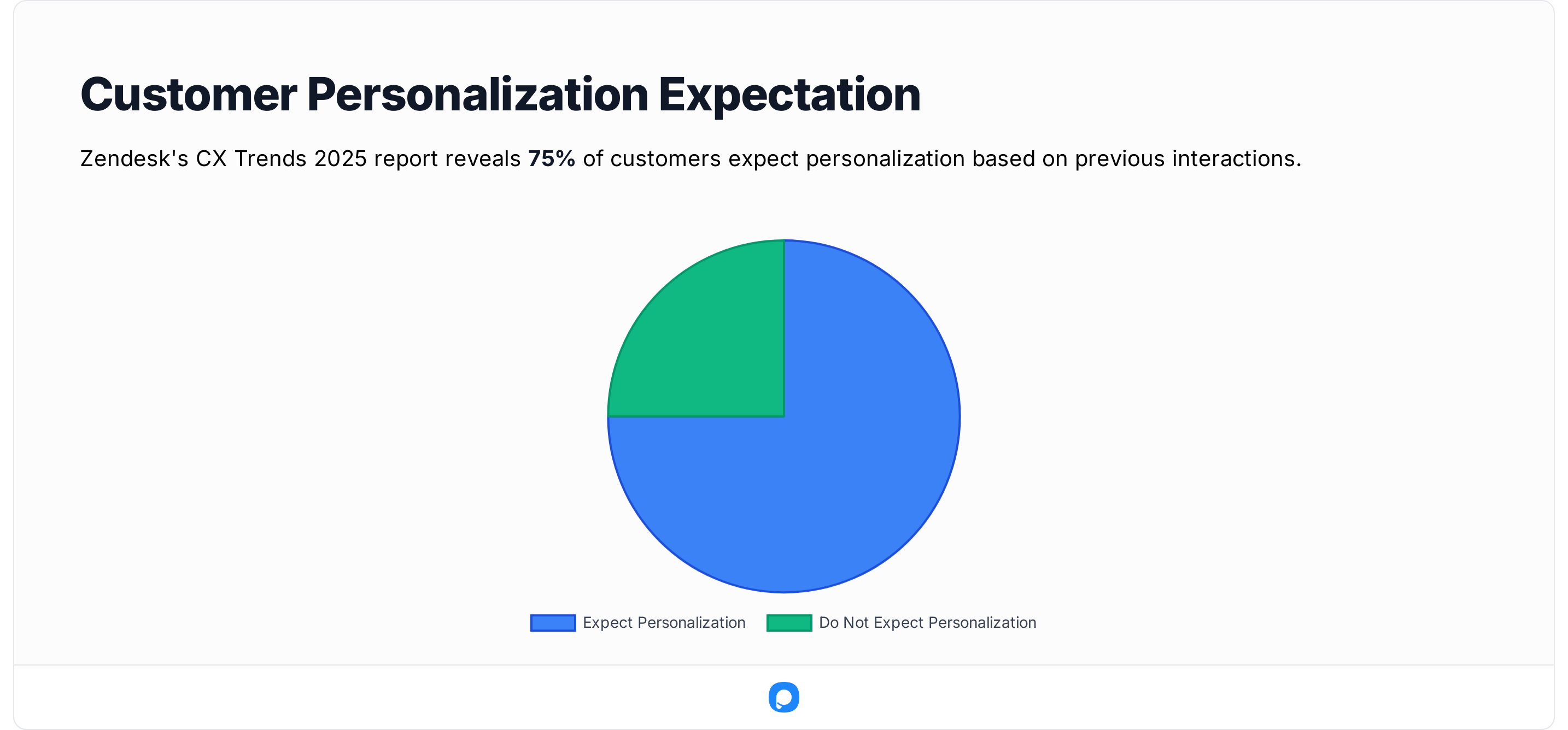
That expectation makes returning-visitor popups a perfect place to highlight tailored value — not just another form.
📊 Practical Tips I Use in Campaigns
- Segment by visitor type whenever possible.
Show exclusive offers to new visitors (“10 % off your first order”) and updates or loyalty benefits to returning ones. - Limit frequency for returning visitors.
Seeing the same popup repeatedly hurts trust. A cap of 1 per week per visitor works well. - Combine cookie or session logic with behavioral triggers.
For example, show returning visitor offers only after they view a new collection or scroll 50 %. - Keep context fresh.
Swap out creative and copy every 60 days to avoid banner blindness for frequent visitors.
🧠 My Takeaway
New visitors represent a golden opportunity for quick wins — their conversion potential is nearly 1.5× higher than returning visitors.
But long-term growth depends on turning those first-time opt-ins into repeat buyers through personalized messaging.
Use popups not just to convert once, but to re-engage based on history.
✅ In short: First-time visitors click from curiosity; returning ones click for recognition. Design your popup flow accordingly.
🧾 Form Optimization: How Field Count Impacts Conversion
If there’s one universal truth I’ve seen in popup optimization, it’s this:
every extra form field lowers your conversion rate — unless that field adds visible value for the visitor.
Across our 10,000+ Popupsmart campaigns, the sweet spot sits between 2 and 4 fields. Two-field forms provide a great balance between speed and personalization (~5% average conversion), while 4-field forms can push conversion closer to 9% when the offer is strong and context is high-intent. Beyond 6 fields, conversion rates begin to drop and only recover in very specific, high-qualified scenarios.
💡 The “Less Is More” Rule
The fewer details you ask for, the more likely people are to complete the action. For example, in our own data at Popupsmart, successive campaigns with fewer form fields consistently out-performed those with many fields.
This principle is backed by large-scale UX research:
- The Baymard Institute emphasises reducing the number of visible form fields by default in order to minimise abandonment and perceived friction.
- In one detailed study, the same Institute found that the number of form fields impacts overall usability far more than the number of steps.
✍️ Why It Works
Every extra field adds two types of friction:
- Cognitive friction – users begin questioning why each piece of information is required.
- Physical friction – especially on mobile devices, more typing means more chances to abandon.
⚙️ How I Structure Forms in 2025
Here’s the approach I personally use when I build campaigns:
- Awareness stage (cold traffic): 1 field (e.g., email only)
- Consideration stage: 2 fields (e.g., name + email)
- Decision stage (high-intent leads): multi-step form where I ask for more info after initial engagement
🧠 My Takeaway
The optimal popup form is as short as possible — ideally 1–2 fields when your goal is immediate engagement.
If you must ask for more information up front, consider using a multi-step approach: ask the essential info first, then gradually follow-up once some trust or engagement is established.
✅ Quick recap:
- 1–2 fields = best overall performance.
- Avoid 5+ fields unless absolutely necessary.
- Use auto-fill and keyboard-friendly layouts for mobile.
- Test multi-step flows — they often double or triple completion rates.
💬 With or Without Teasers: Engagement Comparison
One of the most interesting findings from this year’s dataset was how the presence of a teaser — a small clickable icon or bar that expands into a full popup — changes engagement patterns.
Teasers are often used to make popups feel less intrusive, giving visitors control over when to open them. But as our numbers show, the trade-off between “soft visibility” and “direct conversion” can be significant.
💡 What the Data Shows
Campaigns without teasers consistently converted better — roughly 13 percentage points higher than those that used teasers.
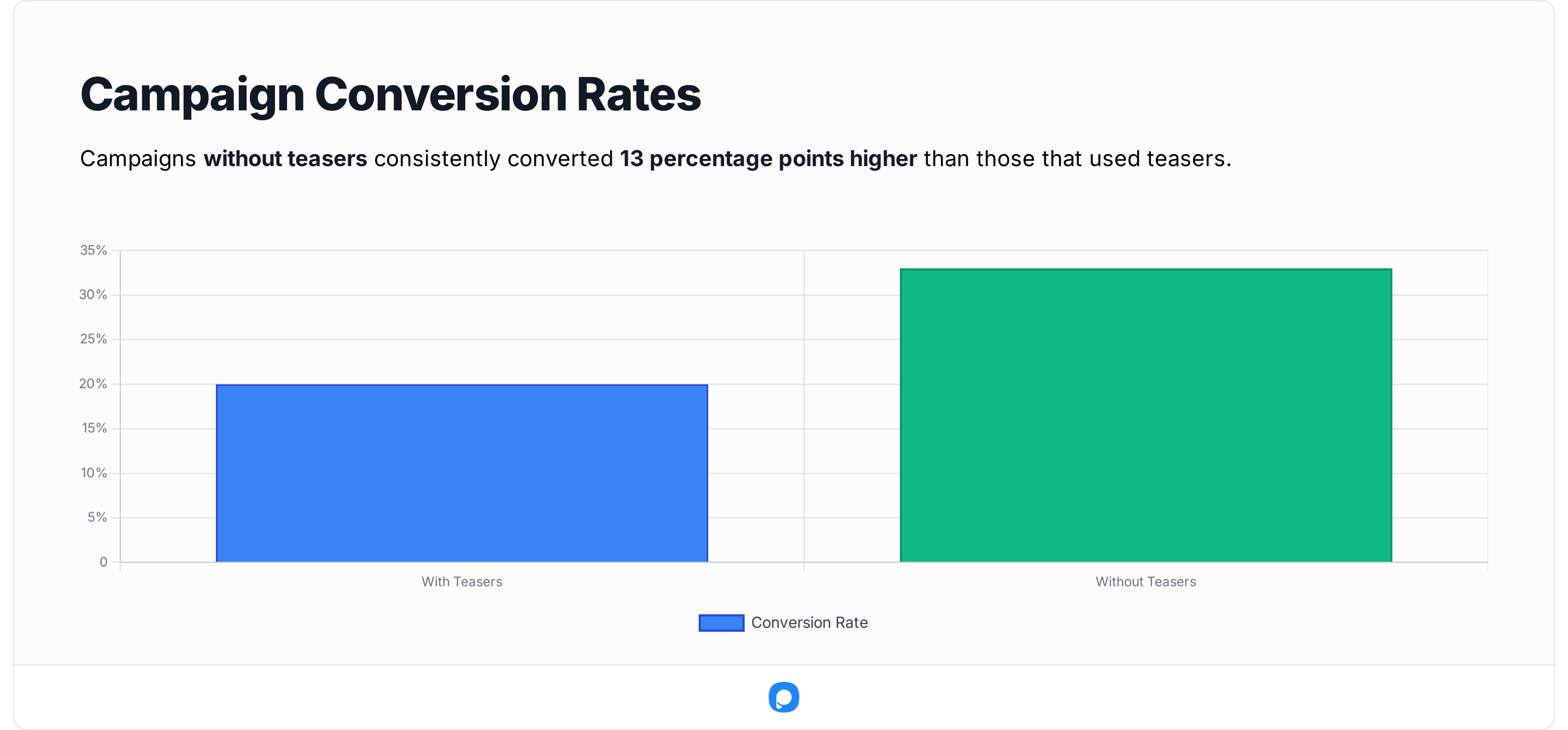
The reason, I believe, is simple: the extra click creates mild friction. Most users engage when the offer is presented immediately and clearly.
However, teasers aren’t useless; they serve an important UX role on high-traffic or editorial sites where constant popups could feel disruptive.
🧭 When to Use Teasers — and When Not To
Use teasers when:
- Your visitors spend more than ~60 seconds per session (e.g., blogs, learning platforms).
- You want to build familiarity rather than immediate action.
- You plan to trigger the main popup contextually (scroll 50 %, inactivity 10 s, etc.).
Avoid teasers when:
- The goal is a direct conversion such as “Sign up now” or “Get 10 % off”.
- You already have limited screen space (mobile layouts, single-column pages).
- You’re running short-session traffic (e.g., ads, flash campaigns).
According to Nielsen Norman Group, when the effort required for a user to complete an action increases (“interaction cost”), engagement drops significantly.
In practical terms for popups, that means whenever a visitor must perform an extra step (such as opening a teaser, navigating a layered interface, or answering more fields), you’re adding friction — and every bit of friction reduces conversion likelihood.
🧠 My Takeaway
If your primary KPI is lead capture, skip the teaser and go straight to a well-timed popup.
If your goal is brand recall or retention, keep the teaser active — it builds user control and prevents “popup fatigue.”
In other words, think of teasers as polite persistence: they don’t shout, but they keep the door open.
✅ Quick recap:
- No-teaser popups convert higher because they remove friction.
- Teasers enhance UX and retention on content-heavy or returning-visitor sites.
- The best setup: a teaser + exit-intent combo — quiet at first, assertive when intent peaks.
🧭 Benchmarks by Industry (2025 Averages)
Every industry plays by its own conversion rules.
That’s why I like to compare popup data not just in isolation, but against broader sector-level performance.
When I analyzed our 10,000+ Popupsmart campaigns, I segmented results across five major verticals — and the patterns were remarkably consistent with what wider marketing data shows in 2025.
🧭 Benchmarks by Industry (2025 Averages) — Breakdown
Every industry plays by its own conversion rules.
That’s why I always compare Popupsmart’s internal dataset with credible external research before drawing conclusions. Numbers without context can be misleading — and in 2025, the contrasts between verticals are clearer than ever.
🛍 E-Commerce and Retail
E-commerce still leads the way.
When visitors are already in “shopping mode,” even a small incentive — like free shipping or 10 % off — can trigger immediate action.

In our dataset, exit-intent popups with limited-time offers performed especially well, and the best performers combined urgency with personalization.
That pattern aligns with broader research: the average online-store conversion rate is about 3.6 %, yet personalized onsite messages can lift performance by 20 – 25 %.
So even though popups and full-page modals can feel old-school, they remain one of the few tools that reliably move the needle for online stores.
💻 SaaS and Software
SaaS campaigns are a different game.
They run on lower traffic but higher intent — and that changes how popups perform.
Across our data, SaaS popups perform strongest when focused on free-trial or demo-request CTAs shown after the visitor explores product details.
Industry benchmarks help explain why.
First Page Sage report that organic visitor-to-trial conversions hover around 8.5 %, while free-to-paid upgrades land between 10 % and 25 %.

That means popups in SaaS aren’t meant to close the sale — they’re meant to spark the trial.
In my experience, timing them after engagement (e.g., when users visit the pricing or feature page) nearly doubles response rates versus showing them immediately.
🎓 Education and Nonprofits
Education and nonprofit campaigns tend to rely on storytelling and trust, not urgency — and their popups reflect that.
In our 2025 dataset, scroll-based or delayed popups performed best for education and nonprofit campaigns, where visitors tend to spend more time reading before they act.
That makes sense when you look at audience behavior: the Unbounce Education Conversion Report shows that education landing pages convert at a median 8.4 %, one of the highest among all industries.

In other words, these visitors spend more time reading before they act — and patient, context-aware popups win.
🧾 Agencies and Professional Services
For agencies and service businesses, the goal isn’t a one-click signup — it’s starting a conversation.
In our dataset, consultation popups (“Book a free call,” “Get a quote”) often outperformed newsletter offers by a wide margin.
This matches independent research: the Focus Digital Lead Magnet Benchmark study finds average B2B lead magnets convert 8–12 % of visitors , depending on offer strength.

When those offers are paired with real-time personalization (such as location or service type), conversion rates climb even higher.
In my experience, the “book a call” popup only works when it feels consultative, not pushy — for example, offering an audit or strategy session instead of a sales pitch.
🏪 Local Businesses
Local businesses — from salons to clinics to real-estate offices — use popups differently.
Their traffic volume is lower, but intent is high: visitors are usually ready to book or call.
Our internal numbers show strong performance for click-to-call, map, or appointment popups, especially on high-intent local traffic.
External data backs that behavior.
According to Thrive Themes’ 2025 small-business marketing review, 57 % of local searches come from mobile devices, and 28 % of those searches lead to a purchase within 24 hours.
That’s why mobile-first popups — with one-tap “Call Now” or “Get Directions” buttons — remain essential for local businesses.
🧠 My Takeaway
After comparing our dataset to public benchmarks, one thing stands out:
every industry wins differently.
E-commerce thrives on urgency, SaaS on timing, education on trust, agencies on consultation, and local businesses on immediacy.
The common thread?
All successful popups respect the user’s intent.
When timing, message, and design align with what the visitor actually came to do, the numbers take care of themselves.
✅ Quick summary:
- E-commerce popups still dominate conversion volume.
- SaaS and service businesses see the best quality leads.
- Education and nonprofit audiences prefer slow, contextual engagement.
- Local businesses thrive on immediacy — call, map, or booking CTAs.
🔍 My Insights: Why These Numbers Matter
Whenever I publish benchmark reports like this, the first thing people ask me is:
“Okay, but what do these numbers actually mean for my business?”
After spending months digging through data from over 10 000 popup campaigns, here’s what I’ve learned — and how you can translate the raw percentages into real-world strategy.
💡 1. Engagement Is the New Conversion
The days of chasing “clicks” are over. What matters now is engagement quality.
A popup that drives 50 % interactions but irrelevant leads isn’t winning — it’s just busy.
In practice, this means your first goal isn’t the sale; it’s the conversation.
🧠 2. Relevance Beats Frequency
In my experience, fewer but smarter popups outperform sites filled with overlapping prompts.
A Zendesk CX survey revealed that 62 % of users associate “too many popups” with brand annoyance, yet 72 % say they welcome personalized, well-timed offers. The message is clear: success isn’t about showing more — it’s about showing right.
One relevant popup can outperform five generic ones.
📈 3. The Human Element Still Wins
Even as automation grows, the highest-performing campaigns have something deeply human about them.
Popups that use empathy-driven copy (“Need help finding the right plan?”) or contextual tone outperform purely transactional ones by wide margins.
⚙️ 4. Data Should Guide, Not Dictate
Benchmarks are starting lines, not ceilings.
When McKinsey analyzed 300 digital growth programs, teams that ran ongoing A/B tests based on customer insight (rather than copying benchmarks) achieved 2–3× faster ROI growth.
That’s why I always tell marketers: use numbers as navigation, not prescription.
🧭 My Personal Takeaway
After working with so many datasets, I’ve realized benchmarks only matter when you apply them with empathy.
Behind every “conversion” is a real person — scanning your copy, deciding in seconds whether your brand feels trustworthy.
So yes, study the numbers, but build for the human on the other side of the screen.
That’s where true optimization happens.
✅ In short:
- Focus on engagement, not interruption.
- Prioritize timing and personalization.
- Don’t chase averages — design experiences that feel human.
🧾 Conclusion
Looking back at more than 10,000 popup campaigns, the story behind the numbers is simple but powerful:
popups still work — not because they’re flashy, but because they’ve become smarter.
In 2025, the popups that win are the ones that feel human: they respect timing, reduce friction, and appear when the visitor actually wants help.
Here’s what this year’s data told me loud and clear:
- The average popup conversion rate is 3.49%, but the top-performing setups — the right position, effect, and offer — can push well above 10–15% in our dataset.
- Time-on-page triggers consistently outperform everything else.
- Mobile conversions now nearly match desktop — proof that responsive design and shorter forms pay off.
- The sweet spot for forms remains 1–2 fields; every extra question costs you leads.
- Context beats frequency: one well-timed popup is worth ten random ones.
If I had to summarize it in one line:
👉 Relevance, not repetition, drives conversions in 2025.
And that’s really what this entire benchmark is about — using data not as decoration, but as direction.
Whether you’re running an e-commerce store, a SaaS product, or a local business, your visitors will always reward experiences that feel natural and considerate.
If you remember only one thing from this report, make it this:
popups convert when they respect the user journey.
❓ FAQ
1. What’s a good popup conversion rate in 2025?
Based on 10,000+ campaigns, anything around 3–4% is solid, and 8%+ sits in top-tier performance territory in our 2025 dataset.If you’re below 1.5%, focus on better triggers, clearer offers, and simpler forms.
2. Do popups still work on mobile?
Absolutely. Our 2025 data shows mobile popup conversions grew by 15 % year-over-year.
The key is responsive design and fewer form fields — don’t recycle desktop layouts.
3. Which popup trigger is the most effective?
“Time-on-page” triggers (around 30–45 seconds) convert best for most industries, followed by exit-intent.
Scroll-depth works great for blogs or content pages where the user is already engaged.
4. Should I always use a teaser?
Not always. Teasers improve UX on content-heavy sites but reduce conversions slightly (roughly 13 % lower on average).
Use them strategically — they’re better for long-session traffic than direct lead-gen offers.
5. What’s the biggest mistake I see brands make?
Overexposure. Showing too many popups too early.
It damages trust.
Patience and personalization almost always outperform frequency.
💬 Final Thought
If you’ve read this far, you’re already thinking like a data-driven marketer.
This benchmark isn’t meant to be a rulebook — it’s a roadmap.
Use it to measure, adapt, and most importantly, experiment.
Because the truth is: there’s no single “best” popup — only the one that feels right at the right moment for your visitor.
You may also enjoy following blogs:
